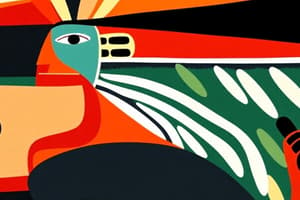Podcast
Questions and Answers
What was the primary architectural structure of the Iroquois Confederacy?
What was the primary architectural structure of the Iroquois Confederacy?
- Tipi
- Longhouse (correct)
- Pueblo
- Igloo
The Iroquois economy was primarily based on hunting, with women not involved in agricultural practices.
The Iroquois economy was primarily based on hunting, with women not involved in agricultural practices.
False (B)
What method did the Iroquois use for farming that helped to grow corn, beans, and squash together?
What method did the Iroquois use for farming that helped to grow corn, beans, and squash together?
The 'Three Sisters' farming method
The Iroquois Confederacy primarily inhabited the northeastern part of what is now the United States, especially in present-day ______.
The Iroquois Confederacy primarily inhabited the northeastern part of what is now the United States, especially in present-day ______.
Match the following Iroquois roles with their functions:
Match the following Iroquois roles with their functions:
What were wampum belts made from?
What were wampum belts made from?
The Iroquois were known for their passive interactions with neighboring Indigenous groups and European settlers.
The Iroquois were known for their passive interactions with neighboring Indigenous groups and European settlers.
In what areas did the influence of the Iroquois extend beyond their original territory?
In what areas did the influence of the Iroquois extend beyond their original territory?
Which nations originally composed the Iroquois Confederacy?
Which nations originally composed the Iroquois Confederacy?
The Iroquois Confederacy was formed after European contact.
The Iroquois Confederacy was formed after European contact.
Who are the main leaders credited with the founding of the Iroquois Confederacy?
Who are the main leaders credited with the founding of the Iroquois Confederacy?
The Iroquois Confederacy is also known as the ______.
The Iroquois Confederacy is also known as the ______.
Match the following events with their corresponding periods:
Match the following events with their corresponding periods:
What document served as the guiding constitution for the Iroquois Confederacy?
What document served as the guiding constitution for the Iroquois Confederacy?
The Iroquois Confederacy was unified in its support during the American Revolution.
The Iroquois Confederacy was unified in its support during the American Revolution.
What ongoing issue do the Iroquois face regarding their rights?
What ongoing issue do the Iroquois face regarding their rights?
Flashcards are hidden until you start studying
Study Notes
Definition
- The Iroquois Confederacy, also known as Haudenosaunee or the Six Nations, consists of six Indigenous nations: Mohawk, Oneida, Onondaga, Cayuga, Seneca, and Tuscarora.
- The term "Haudenosaunee" translates to "People of the Longhouse," symbolizing unity among the nations.
- The Confederacy is recognized for the Great Law of Peace, which acted as their constitution for governance.
History
- Established before European contact, with oral traditions suggesting formation around 1142.
- Founded by leaders Deganawida (the Great Peacemaker) and Hiawatha to unite warring nations for peace.
- Iroquois engaged in the fur trade with Europeans, particularly Dutch and English settlers.
- Played significant roles in the Beaver Wars and the French and Indian War, establishing influential alliances.
- The Confederacy fractured during the American Revolution, with nations split in their support of British or American forces, leading to land loss.
- Continued pressures from U.S. and Canadian governments resulted in cultural suppression, though the Iroquois maintain political sovereignty today.
Legacy
- The Confederacy's governance model has been theorized to influence the U.S. Constitution, particularly in federalism and representative democracy.
- The Iroquois remain active in advocating for their rights and sovereignty.
Art and Architecture
- Notable art forms include beadwork, wampum belts (used for recording treaties), wood carvings, and pottery.
- Longhouses served as communal homes, symbolizing unity, and housed related families organized by matrilineal kinship.
Interaction with Other Cultures
- The Iroquois engaged in strategic alliances and rivalries with surrounding Indigenous groups and European settlers, particularly during the fur trade and colonial wars.
- Their diplomatic efforts impacted broader Indigenous and European political landscapes.
Geography
- Originally inhabited the northeastern U.S., primarily New York state, with fertile river valleys and forests suitable for agriculture.
- Their influence stretched into Canada and the Ohio Valley, enhanced by trade and warfare.
Technology and Science
- Innovators in agriculture, utilizing methods like the "Three Sisters"—growing corn, beans, and squash together for mutual soil benefits.
- Proficient hunters, trappers, and builders, effectively leveraging environmental knowledge.
Economy
- Economy rooted in agriculture, trade, and hunting; women primarily managed farming, while men focused on hunting and trapping.
- Engaged in valuable trade, especially in furs, with both Indigenous and European partners.
Political System
- One of the oldest participatory democracies globally, governed by the Great Law of Peace.
- Clan mothers selected male leaders known as "sachems" or chiefs to participate in a Grand Council for consensus-based governance.
- The Confederacy operated through a decentralized structure, promoting communal decision-making.
Studying That Suits You
Use AI to generate personalized quizzes and flashcards to suit your learning preferences.




